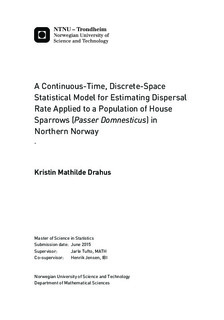A Continuous-Time, Discrete-Space Statistical Model for Estimating Dispersal Rate Applied to a Population of House Sparrows (Passer Domnesticus) in Northern Norway
Master thesis
Permanent lenke
http://hdl.handle.net/11250/2352638Utgivelsesdato
2015Metadata
Vis full innførselSamlinger
Sammendrag
How individuals move and interact with each other is a complex matter. Even so, the knowledge of how such movements and interactions happen is important to understand in order to be able to keep genetic variation and prevent extinction of species. Also it is important to be able to limit dispersal of unwanted diseases or pests. In this thesis I have investigated different models for dispersal rates for individuals in a set of partially isolated subpopulations of house sparrows in Northern Norway. The models differ in what factors contribute to increase or decrease the dispersal rate. By using such models one can get a broader understanding of what may cause an individual to disperse from one location to another, and hence it gives a pointer in what way one should act in order to adjust the dispersal.
In my master's thesis I have used discrete localities and continuous time. The localities are defined to be the ten farms on the island where observations were made. In the study, distance as well as home locality, sex and date is tested for contributions to the dispersal rate. The expanded models seem to give a more likely result than the simple ones, suggesting that all the factors tested for make a significant improvement to the model and that the dispersal is in fact affected by many factors.
